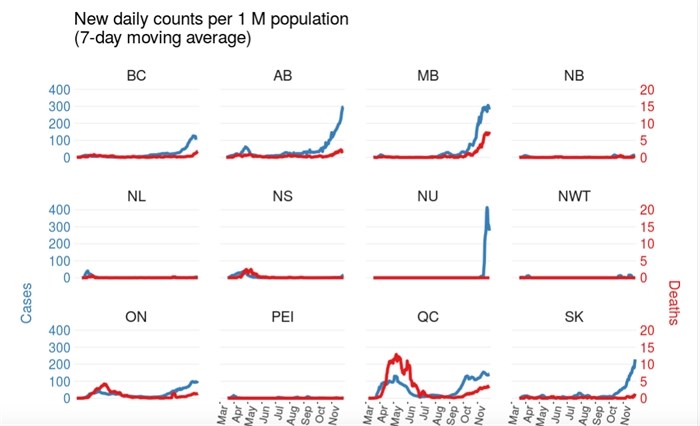
A nurse gets a swab ready at a temporary COVID-19 test clinic in Montreal, on Friday, May 15, 2020.
Image Credit: THE CANADIAN PRESS/Paul Chiasson
December 01, 2020 - 6:00 AM
So far in B.C.’s COVID-19 pandemic, young adults are leading the way in the proportion of the population testing positive.
But those over 80 years of age are disproportionately hospitalized and more likely to die. While that’s not new, there is a growing shift during this second wave towards more elderly people getting sick.
“Of concern, adults 80-plus had amongst the highest incidence at 116 per 100,000 which is 35% higher than in week 46 and 16 times higher than in week 38,” states a B.C. Centre for Disease Control situation report. The report focuses on the third week of November, which is the 47th week of the year. Week 38 is the middle of September when schools reopened.
READ MORE: B.C. has staggering 46 COVID-19 deaths since Friday
Provincially, 77 per 100,000 B.C. residents tested positive during the third week of November, so the 116 per 100,000 for those over 80 is significantly higher.
The report doesn’t break down the week by age group but does show that since the pandemic began in January, people aged 20 to 29 make up 14 per cent of the province’s population but accounted for 23 per cent of the cases. Those in the next age bracket, 30 to 39, also make up 14 per cent of the population but accounted for 19 per cent of the cases.

Image Credit: Submitted/B.C. Centre for Disease Control
Only one of the people in those two age groups died from COVID-19.
By comparison, those aged 80 to 89 make up four per cent of the population, accounted for three per cent of the cases but experienced 40 per cent of the deaths (140 of 354 at that time).
This is not just a reflection of massive outbreaks in long-term care homes in the early days of the pandemic. In the third week of November, seven per cent of the new cases were amongst people aged over 80 even though they make up only five per cent of the population.
From January until the third week of November, there were 28,718 cases or 557 per 100,000 population.
The Fraser Health region accounted for 18,000 of those cases, a rate of 928 per 100,000.
Another 8,067 cases were in Vancouver Coastal with 666 cases per 100,000.
With 1,356 cases the Interior came in at 162 cases per 100,000 which is actually lower than the sparsely populated Northern Health region where 674 cases translated into 235 cases per 100,000.
Despite the dramatic rise in cases in B.C., the province isn’t doing that bad compared to the rest of Canada.
The graph below shows the number of cases per one million population in Canada, in blue, from January though Nov. 27. The red line represents the number of deaths per million.

Image Credit: Submitted/B.C.Centre for Disease Control
To contact a reporter for this story, email Rob Munro or call 250-808-0143 or email the editor. You can also submit photos, videos or news tips to the newsroom and be entered to win a monthly prize draw.
We welcome your comments and opinions on our stories but play nice. We won't censor or delete comments unless they contain off-topic statements or links, unnecessary vulgarity, false facts, spam or obviously fake profiles. If you have any concerns about what you see in comments, email the editor in the link above.
News from © iNFOnews, 2020